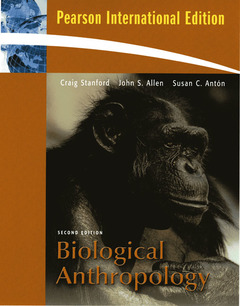Description
Biological anthropology
Authors: STANFORD Craig, ALLEN John S., ANTON Susan C.
Language: English
Approximative price 91.63 €
Subject to availability at the publisher.
Add to cart624 p. · 21.6x27.6 cm · Paperback
Description
/li>Contents
/li>
For undergraduate introductory physical anthropology, biological anthropology or human origins courses.
Biological Anthropology, 2/e continues to build upon the strength and success of the first edition by integrating the foundations and the most current innovations in the field from the ground up.
Over the past twenty years, this field has rapidly evolved from the study of physical anthropology into biological anthropology,incorporating the evolutionary biology of humankind based on information from the fossil record and the human skeleton,genetics ofindividuals and of populations, our primate relatives, human adaptation, and human behavior.The second edition of Biological Anthropology combines the most up-to-date, comprehensive coverage of the foundations of the field with modern innovations and discoveries.
Introduction: What Is Biological Anthropology?
The Scope Of Biological Anthropology
The Roots Of Modern Biological Anthropology
Anthropology And Its Other Subfields
Summary Critical Thinking Questions Key Terms Suggested Readings
Part I: Mechanisms of Evolution
Chapter 1: Origins of Evolutionary Thought
What Is Science?
The Early Thinkers
The Road To The Darwinian Revolution
The Darwinian Revolution
The Response To Darwin
Science And Creationism
Summary Critical Thinking Questions Key Terms Suggested Readings
Chapter 2: Genetics: Cells and Molecules
Genetics
The Cell
DNA Structure And Function
Molecular Tools For Bioanthropological Research
Summary Critical Thinking Questions Key Terms Suggested Readings
Chapter 3: Genetics: From Genotype to Phenotype
From Genotype To Phenotype
Mendelian Genetics
Mutation
Genetics Beyond Mendel
Phenylketonuria: Illustrating Mendelian And Post-Mendelian Concepts
Genes And Environments
Summary Critical Thinking Questions Key Terms Suggested Readings
Chapter 4 : The Forces of Evolution and the Formation of Species
How Evolution Works
Classification And Evolution
Levels Of Selection
Summary Critical Thinking Questions Key Terms Suggested Readings
Chapter 5: Human Variation: Evolution, Adaptation, and Adaptability
Human Variation At The Individual And Group Level
Historical Perspectives On Human Variation
Population Genetics
Polymorphisms And Natural Selection In Human Populations
Adaptation And Adaptability
Summary Critical Thinking Questions Key Terms Suggested Readings
Part II: PRIMATES
Chapter 6: The Primates
The Primate Radiation
A Guide To The Nonhuman Primates
Primate Ecology
Primate Communities
Summary Critical Thinking Questions Key Terms Suggested Readings
Chapter 7: Primate Behavior
Studying Primates
The Evolution Of Primate Social Behavior
Why Are Nonhuman Primates Social?
Reconstructing The Evolution Of Primate Societies
Summary Critical Thinking Questions Key Terms Suggested Readings
Part III: PALEONTOLOGY AND PRIMATE EVOLUTION
Chapter 8: Fossils in Geological Context
How To Become A Fossil
The Importance Of Context
How Old Is It?
The Earth In The Cenozoic
Summary Critical Thinking Questions Key Terms Suggested Readings
Chapter 9: Origin of Primates
The Mesozoic And Beyond
Changes In The Paleocene: Origin Of The Primates?
Early Primates Of The Eocene
Evolution Of Higher Primates
Molecular Evolution In Primates
Summary Critical Thinking Questions Key Terms Suggested Readings
Chapter 10: Becoming Human: The Ape-Hominid Transition
Becoming a Biped
The Transition to Human Behavior
Summary Critical Thinking Questions Key Terms Suggested Readings
Part IV: The Human Fossil Record
Chapter 11: Early Hominids
Will You Know A Hominid When You See One?
The First Hominids?
Australopithecus And Kin
U
These books may interest you

Anthropology For Dummies 22.39 €

Human Biological Diversity 99.36 €

Human Biological Diversity 208.65 €

